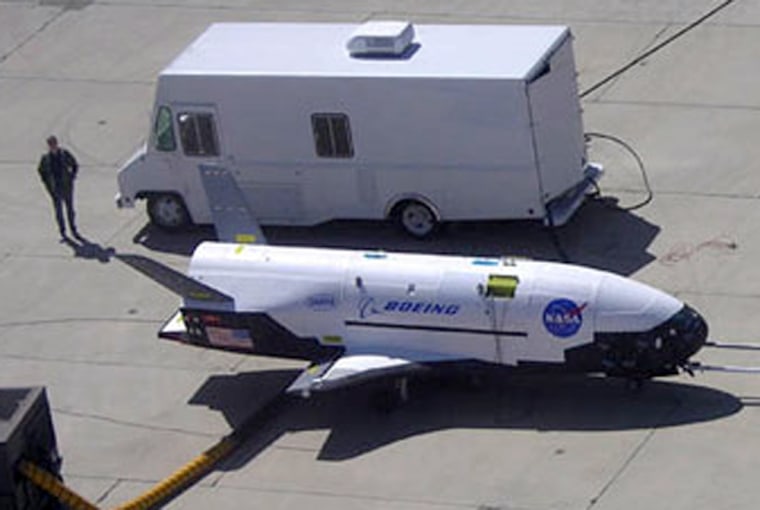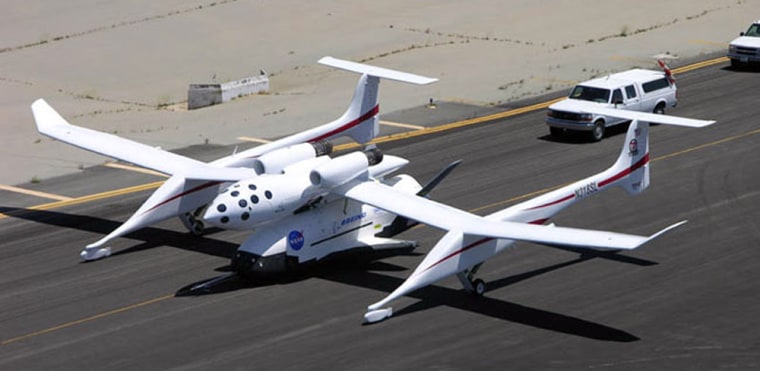The innovative carrier plane used to air-launch SpaceShipOne has a new mission. At its inland spaceport in Mojave, Calif., the White Knight mothership has been involved in fit and high-speed taxi checks with a new passenger: the X-37, an unpiloted, reusable space plane.
The White Knight/X-37 combination has undergone a set of recent ground evaluations, including high-speed taxi testing this week.
Designed by Scaled Composites of Mojave, the White Knight hauled SpaceShipOne to altitude and then released the piloted rocket plane for its record-setting suborbital treks, including the snagging of the high-stakes $10 million Ansari X Prize last year.
In its new role, the White Knight is being readied to carry the X-37, a vehicle supported by the Boeing Co., NASA and the Pentagon's Defense Advanced Research Projects Agency, or DARPA. No official word yet on when the twosome will take to the air, or on the time frame for the first drop test of the X-37 using the White Knight.
Technology testbed
The X-37 has been billed as an unpiloted, autonomously operated vehicle designed to conduct on-orbit operations and collect test data in the Mach 25 (re-entry) region of flight.

The Boeing-built X-37 is geared to be a test bed for airframe, propulsion and operation technologies designed to make space transportation and operations significantly more affordable.
According to a Boeing fact sheet on the craft, the X-37 project is exploring potential new commercial and military reusable space vehicle market applications, be they on-orbit satellite repair to the next-generation of totally reusable launch vehicles.
Late last year, NASA transferred its X-37 technology demonstration program to DARPA.
The Approach and Landing Test Vehicle, or ALTV, has been at the Mojave airport since mid-April, explained Jan Walker, a DARPA spokesperson. “The first taxi test occurred earlier this month. In addition to the taxi tests, the ALTV also plans captive-carry flights and drop tests. The tests will continue through this summer, but we’ve not announced any specific dates,” Walker told Space.com.
Checkered history
NASA’s involvement in the X-37 dates back to 1998, when the project was selected as the first of a planned series of flight demonstrators dubbed Future X. At the time, NASA agreed to share the X-37’s projected $173 million cost with Boeing and the U.S. Air Force. After the Air Force announced in 2001 that it would stop funding the project, NASA told Boeing that the company would have to submit a new proposal for the X-37 to be eligible for additional funding.
After persistent prodding from U.S. Rep. Dana Rohrabacher, R-Calif.), NASA in 2002 awarded Boeing a $301 million contract for two X-37 vehicles instead of one. One of those vehicles would conduct a series of drop tests within the atmosphere, paving the way for the flight of the orbit and re-entry vehicle in 2006.
But NASA advised Boeing in late 2003 to throttle back on development of the orbit and re-entry vehicle, and directed Boeing to stop work on that part of the program altogether. The X-37 was dealt a further setback last year when a NASA review concluded that the program was not a good fit with the agency’s new space exploration agenda.
Brian Berger of Space News contributed to this story.
